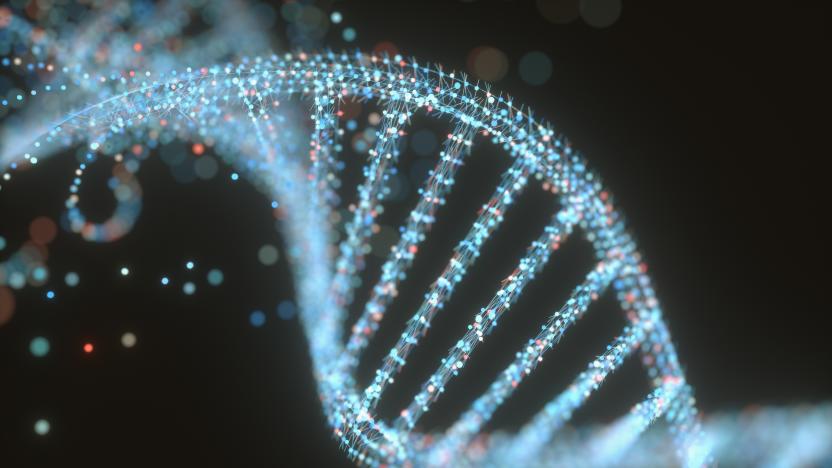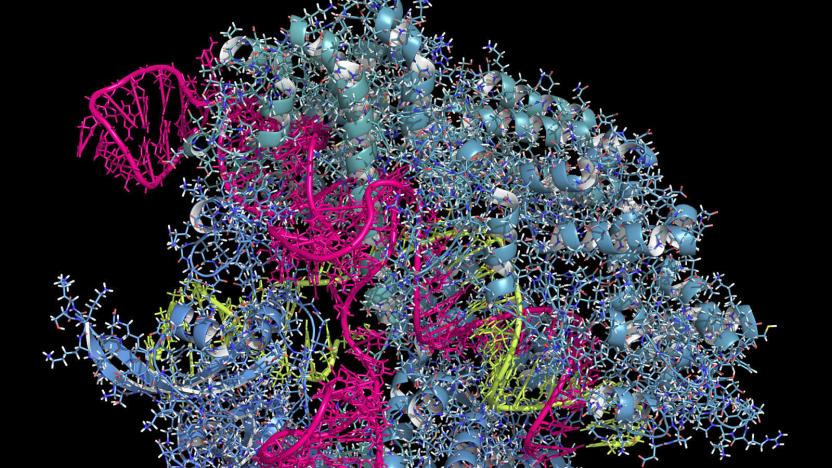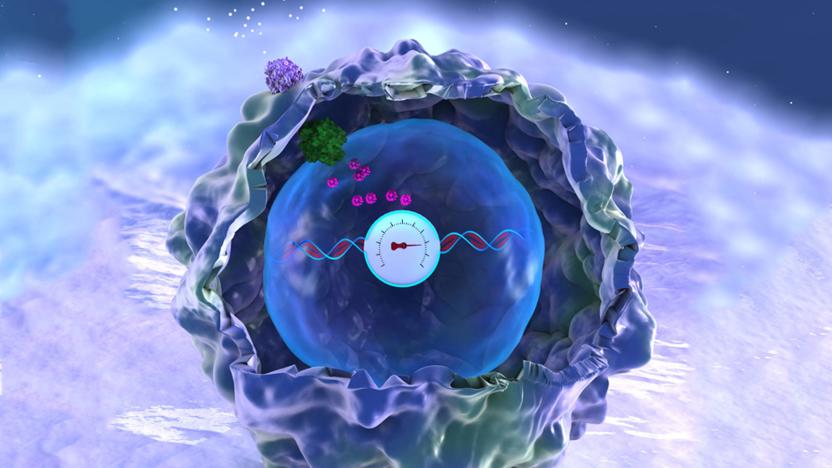RNA
Latest

CRISPR gene editing pioneers win the 2020 Nobel Prize in Chemistry
CRISPR gene editing pioneers Emmanuelle Charpentier and Jennifer Doudna have won the 2020 Nobel Prize in Chemistry for a 'revolutionary' impact on science.

Scientists rename genes because Microsoft Excel reads them as dates
Scientists have been renaming human genes to prevent Microsoft Excel from misreading them as dates and corrupting data.

New CRISPR tool alters RNA for wider gene editing applications
The CRISPR gene editing technique can be used for all sorts of amazing things by targeting your DNA. Scientists are using it in experimental therapies for ALS and Huntington's disease, ways to let those with celiac disease process gluten proteins and possibly assist in more successful birth rates. Now, according to a paper published in Science, researchers have found a way to target and edit RNA, a different genetic molecule that has implications in many degenerative disorders like ALS.

Gene editing technique could treat ALS and Huntington's disease
The most common gene editing technique, CRISPR-Cas9, only modifies DNA. That's helpful in most cases, but it means that you can't use it to tackle RNA-based diseases. Thankfully, that might not be a problem for much longer. After plenty of talk about editing RNA, researchers have developed a new RNA-oriented technique (RCas9) that can correct the molecular errors which lead to diseases like hereditary ALS and Huntington's.

Atomic 'photos' help make gene editing safer
Believe it or not, scientists haven't had a close-up look at CRISPR gene editing. They've understood its general processes, but not the minutiae of what's going on -- and that raises the risk of unintended effects. They'll have a much better understanding going forward. Cornell and Harvard researchers have produced snapshots of the CRISPR-Cas3 gene editing subtype (not the Cas9 you normally hear about) at near atom-level resolution. They used a mix of cryo-electron microscopy and biochemistry to watch as a riboprotein complex captured DNA, priming the genes so the namesake Cas3 enzyme can start cutting. The team combined hundreds of thousands of particles into 2D averages of CRISPR's functional states (many of which haven't been seen before) and turned them into 3D projections you can see at the source link.

Scientists reverse Alzheimer's-like symptoms in mice
Scientists have discovered a way of counteracting the proteins that cause Alzheimer's-like symptoms including memory loss. In mice, at least. Whereas other treatments have focused on beta-amyloid clumps (which the University of Michigan recently discovered how to "fingerprint"), researchers at Washington University in St. Louis, Missouri focus on tau protein tangles. Specifically, the genes that produce them.

Crop spray gives plants GMO benefits without altering genes
Scientists have developed a clay-based RNA spray that turns off certain genes in plants, making them resistant to a virus for up to 20 days. With a single treatment, the researchers were able to protect tobacco plants from the "pepper mild mottle virus," a serious disease transmitted by humans during farm operations. On top of crop protection, the technique could be used to modify the color, taste and appearance of plants, but unlike with GMO plants, the underlying DNA would not be changed.

Scientists track gene parts controlling the embryo's early growth
Techniques like CRISPR and even experimental methods like programmable bacteria can be used to edit genes, but knowing which genes to edit is crucial. Yale scientists have found a way to track the types of RNA that control embryonic development in living animals, which might lead to a greater understanding of the whole process.

Science exonerates HIV's 'Patient 0'
For years, many have pinned HIV's US outbreak on one man: a flight attendant, nicknamed Patient 0, whose travels and sexual activity allegedly helped spread the virus quickly. However, there's now evidence to suggest that he was little more than a scapegoat. A team of American and British researchers has used genetic reconstruction to narrow down the American arrival of HIV to between 1970 and 1971, before Patient 0 was even having sex.

Gene editing records 'memories' in human DNA
Scientists have been recording data in DNA for a while, but it has usually involved bacteria and other simple organisms. MIT, however, just took a big leap forward. Its researchers have used the CRISPR gene editing technique to record histories in human cell DNA for the first time. They've crafted a gene circuit that only expresses an enzyme when it's near a key immune cell molecule, building up mutations the more it's exposed to that molecule. All you have to do to extract "memories" is to sequence those genes. They'll tell you whether or not there was a lot of inflammation, for instance.

RNA gene editing could stop viruses in their tracks
The gene editing technique CRISPR promises to treat all kinds of genetically-linked conditions, but it's so far limited to tweaking DNA, not the RNA that does everything from carrying protein sequence info to regulating gene expression. That may change soon, however. Scientists have discovered that a commonplace mouth bacterium (Leptotrichia shahii) can be programmed to break down whatever RNA you want. You could rip apart viruses, which are frequently based solely around RNA, or kill a cancer cell by denying it the chance to make vital proteins.

Researchers create mirror image of DNA-copying protein
Scientists at Tsinghua University in Beijing have created a mirror-image version of a protein responsible for two life-critical functions:, copying DNA and transcribing it into RNA. This is a crucial step in someday making reverse-versions of molecules that could be more resistant to viral attacks.

Scientists show that gene editing can 'turn off' human diseases
Gene editing has already been used to fight diseases, but there's now hope that it might eliminate the diseases altogether. Researchers have shown that it's possible to eliminate facial muscular dystrophy using a newer editing technique, CRISPR (Clusters of Regularly Interspaced Short Palindromic Repeats) to replace the offending gene and 'turn off' the condition. The approach sends a mix of protein and RNA to bind to a gene and give it an overhaul.

Artificial evolution is now possible in chemicals, but life remains elusive
We're still a very long way from creating an evolving lifeform from scratch in a lab. However, the University of Glasgow has managed to foster artificial evolution in chemicals. Their technique uses a 3D printing robot to both create oil droplets and choose the next generation based on desirable properties, like stability. No, the chemicals aren't evolving on their own, but the process works much like natural selection -- after 20 generations, the droplets were noticeably more stable. In the long run, the scientists hope to use this discovery both to study the beginnings of life and maybe, just maybe, create it.

Video game-inspired remote labs could prevent scientific fraud
Scientific error doesn't always come from botched equations or faulty theories but bad behavior, too -- sometimes scientists crack under pressure and contaminate their results by crafting fraudulent, retrospective hypotheses or cherry-picking data to verify a bias. It's a constant problem within the scientific community, but researchers from Carnegie Mellon and Stanford Universities may have stumbled upon an unconventional solution: video games. Specifically, EteRNA, an educational game that teaches players to design RNA molecules online.

Researchers fully 'delete' HIV from human cells for the first time
So far, HIV has eluded a cure because it installs its genome into human DNA so insidiously that it's impossible for our immune system to clear it out. While current treatments are effective, a lifetime of toxic drugs is required to prevent its recurrence. But researchers from Temple University may have figured out a way to permanently excise it using a highly-engineered HIV "editor." Here's how it works: the team analyzed a part of our immune system that fights infection and built a "guide RNA" strand consisting of 20 nucleotides (RNA building blocks). Those strands were then injected into cells typically infected with HIV, like T-cells. There, they targeted the end parts of the virus's gene and snipped out all 9,709 nucleotides that made up its genome. Since the guide RNA strand contained no human DNA sequences, it left the host cell intact -- but free from HIV.

Stanford researchers create genetic transistors, make biologic computing possible
When constructing computer circuits, most folks start with silicon and metal, but not the researchers at Stanford. The boffins in Palo Alto want to build computers out of living tissue, and to that end they've created a biological transistor, called the transcriptor. Transcriptors substitute DNA for semiconductors and RNA for the electrons in traditional transistors -- essentially, the transcriptor controls the flow of a specific RNA protein along a DNA strand using tailored combinations of enzymes. Using these transcriptors, researchers built logic gates to derive true/false answers to biochemical questions posed within living cells. Using these bio-transistors, researchers gain access to data not previously available (like whether an individual cell has been exposed to certain external stimuli), in addition to allowing them to control basic functions like cellular reproduction. This new breakthrough -- when combined with the DNA-based data storage and a method to transmit DNA between cells the school's already working on -- means that Stanford has created all the necessary components of a biologic computer. Such computers would allow man to actually reprogram how living systems operate. Of course, they haven't built a living genetic PC just yet, but to speed up its development, the team has contributed all the transcriptor-based logic gates to the public domain. Looking to build your own biologic computer? A full explanation of the transcriptor awaits below.

Alt-week 8.4.12: buckyballs, bosons and bodily fluids
Alt-week peels back the covers on some of the more curious sci-tech stories from the last seven days. Remember when we told you last week that we live in a strange world? Well, we had no idea what we were talking about. Seriously, things are about to get a whole lot weirder. High school is certainly a head-scratcher, no matter how old you are, but the mathematics of social hierarchies can't hold a candle to the mysteries of the buckyball. And, if the strange behavior of the familiar carbon molecule isn't enough for you, we've got an entirely new molecule to contend with, while the once-elusive Higgs Boson is getting us closer to unlocking the secrets of the universe. It's all pretty heady stuff, which is why we're also gonna take a quick detour to the world of human waste. This is alt-week.

Seven free iOS apps to help you out in the lab
There are apps for converting between weights, volumes and areas, for converting currency and even to calculate your split of the tip at a bar; but what about apps for scientists? An iOS device, like an iPhone, is almost constantly on your person, so why not get some apps for helping you out in the lab? Here are some of the best free apps for your perusal.








